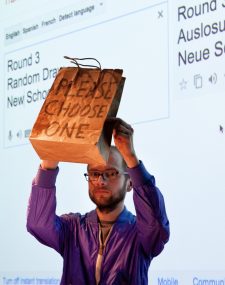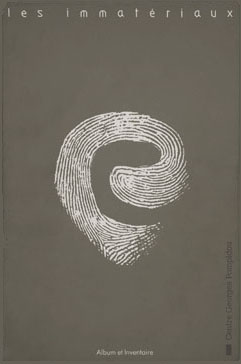Amodern, 8: Translation-Machination (2018)
Filed under journal | Tags: · language, machine, machine learning, media, technique, translation

“Amodern 8 explores the contexts and implications of translation as mechanism, media, technique, and transmission. Our tethering of “translation” to “machination” marks our intention to move beyond the habit of situating MT and computer-generated language in the familiar crisis poses of fakery, treason, and inauthenticity. Rather than regarding the machine as marking the limits of translation – an assumption that risks walling off translation practice from media and communication studies concerns, while still absorbing its products – our aim is to continue to investigate the possibilities and configurations of translation as machined, and translation as machining meaning, historically and in the contemporary moment.”
With contributions by Rita Raley, Otso Huopaniemi, John Cayley, Christine Mitchell, Tiffany Chan, Mara Mills, Jentery Sayers, Avery Slater, Quinn DuPont, Andrew Pilsch, Nick Montfort, Jane Birkin, Karin Littau, and Joe Milutis.
Edited by Christine Mitchell and Rita Raley
Publisher Concordia University and Lakehead University, January 2018
Creative Commons Attribution-Non Commercial 3.0 Unported License
Computational Culture, 5: Rhetoric and Computation (2016)
Filed under journal | Tags: · algorithm, code, computation, language, machine, philosophy, rhetoric, semantics, software studies, theory
“How can machines be rhetorical? The readers of Computational Culture need not be convinced that computation drives the digital and networked spaces in which we interact, argue and communicate: word processing programs, videogames, banking and commerce systems, social networking sites, and smartphone apps that track our data (both with and without our knowledge) are all evidence that computation in code shapes nearly every space we inhabit. Computation in code affects and effects our lives. Computational machines affect us through their programming and design, as well the discourse they can generate, via text, image, sound, and so on. By writing computer code and software, programmers and designers construct machines that make arguments and judgments and address audiences both machinic and human. In this sense, even the most mundane computational technologies can be seen as rhetorical –from the grocery store check-out scanner to the high school graphing calculator–because any computational machine shapes and constrains behavior. […]
Software studies has paved the way for many disciplines to approach software as an object of study and computer programs as written artifacts, and we may add rhetoric to our toolkit to do so. We can use rhetoric to interpret the ways that computation addresses and responds to various audiences and exigencies, makes assertions about identities, and ultimately participates in a complex ecology of forces that shape behavior and perception. This version of rhetoric is more expansive than the limited, Aristotelian definition rhetoric as the ‘available means of persuasion.’ Just as software studies recognizes that software is more than code, and that code is more than ones and zeros, contemporary rhetoric is interested in more than the content of arguments; it also concerns the relational forces that precede and exceed arguments.” (from the introduction)
With thematic texts by Steve Holmes, John Tinnell, Kevin Brock, Elizabeth Losh, Jennifer Maher, Alexander Monea, Andreas Birkbak & Hjalmar Bang Carlsen, Matthew Bellinger; articles by M. Beatrice Fazi, Erica Robles-Anderson and Patrik Svensson, Michael Lachney, William Babbitt & Ron Eglash, and review section.
Edited by Annette Vee and James J. Brown, Jr.
Published in January 2016
Open Access
ISSN 2047-2390
Les Immatériaux: Épreuves d’écriture & Album et Inventaire (1985) [French]
Filed under catalogue | Tags: · architecture, art, cinema, code, computer art, design, industrial design, installation art, kinetic art, language, machine, painting, photography, robotics, sculpture, simulation, writing

“Les Immatériaux was a landmark exhibition co-curated in 1985 for the Centre Georges Pompidou in Paris by philosopher Jean-François Lyotard and design historian and theorist Thierry Chaput, attracting more than 200,000 visitors during the 15 weeks of its duration.
The exhibition brought together a striking variety of objects, ranging from the latest industrial robots and personal computers, to holograms, interactive sound installations, and 3D cinema, along with paintings, photographs and sculptures (the latter ranging from an Ancient Egyptian low-relief to works by Dan Graham, Joseph Kosuth and Giovanni Anselmo). The Centre de Création Industrielle (CCI) – the more ‘sociological’ entity devoted to architecture and design within the Centre Pompidou, which initiated Les Immatériaux – had been planning an exhibition on new industrial materials since at least 1982. Variously titled Création et matériaux nouveaux, Matériau et création, Matériaux nouveaux et création, and, in its last form, La Matière dans tous ses états, this exhibition, first scheduled to take place in 1984, already contained many of the innovative features that found their way into Les Immatériaux.
These features included an emphasis on language as matter, the immateriality of advanced technological materials (from textiles to plastics and holography), exhibits devoted to recent technological developments in food, architecture, music and video, and an experimental catalogue produced using computers. The earlier versions of the exhibition also involved many of the future protagonists of Les Immatériaux, such as Jean-Louis Boissier (among several other faculty members of Université Paris VIII, where Lyotard was teaching at the time) and Eve Ritscher (a London-based consultant on holography). Furthermore, Les Immatériaux benefited from projects pursued concurrently by other groups within the Pompidou which joined Lyotard’s and Chaput’s project when it was discovered that their themes overlapped. Thus, an exhibition project on music videos initiated by the Musée national d’art moderne and a project on electro-acoustic music developed by IRCAM (Institut de Recherche et de Coordination Acoustique/Musique) were incorporated into it.” (from a study by Anthony Hudek, 2009, edited)
Volume 1 contains an experimental glossary of 50 terms with contributions by twenty-six authors, writers, scientists, artists and philosophers including Nanni Balestrini, Michel Butor, François Châtelet, Jacques Derrida, Bruno Latour and Isabelle Stengers. Volume 2 reproduces the works exhibited.
Publisher Centre Georges Pompidou, Paris, March 1985
ISBN 2858502994 (I), 2858503001 (II)
263 (I) and 142 (nonpaginated A4) pages (II)
Épreuves d’écriture (Volume 1, 11 MB, added on 2014-7-30 via Norkhat)
Album et Inventaire (Volume 2, 103 MB, via Arts des nouveaux médias blog of Jean-Louis Boissier)
See also other documents and literature about the exhibition (Monoskop wiki).

